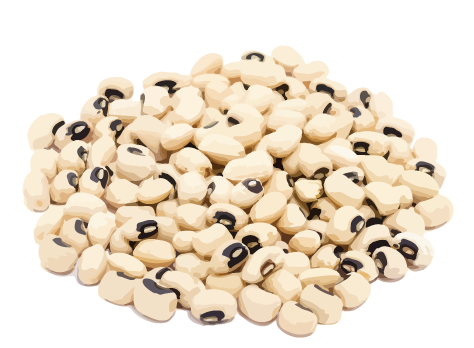Eat Smart, Move More at Farmers Markets: Black-eyed Peas
ID
HNFE-320-11NP

Key Points
- An excellent source of folate and a good source of the B-vitamin thiamin. Also a good source of iron, magnesium, and copper and a rich source of fiber.
- For fresh peas, select hulls that are colorful, firm, clean, and not shriveled. Peas inside should be well-developed. Dried beans should not be discolored or malformed. Pick over and discard unusual looking peas.
- Wash hands with warm water and soap for at least 20 seconds before and after handling fresh fruits and vegetables.
- Shell fresh peas as soon as possible and prepare within three days or freeze. Store dried beans at room temperature in a closed container to protect from moisture and pests.
Black-Eyed Pea and Corn Salad
Number of servings: 12
Ingredients:
2 pounds fresh, shelled black-eyed peas
12 ears corn, shucked, cooked
1 red onion, chopped
1 green pepper, chopped
2 tablespoons canola oil
1/4 cup vinegar
1 teaspoon ground cumin
1/2 teaspoon ground black pepper
Directions:
- Wash peas and pour into saucepan. Cover with water so that there is about 1/2 inch water over peas.
- Bring to a boil, turn down heat to simmer. Simmer for 1 hour or to desired doneness. Drain and allow to cool. Add to medium salad bowl.
- Cut corn off of cobs and add to bowl.
- Add onion and green pepper to bowl. Toss.
- In separate bowl, add oil, vinegar, cumin, and black pepper. Stir well. Pour over vegetables.
- Can serve hot or cold.
Per serving: 361 calories; 4 g fat (1 g saturated fat); 21 g protein; 65 g carbohydrate; 11 g dietary fiber; 0 mg cholesterol; 27 mg sodium.
Black-Eyed Pea Salsa
Number of servings: 16
Ingredients:
3 pounds fresh, shelled black-eyed peas, cooked
2 green peppers, finely chopped
1/2 onion, finely chopped
1 jalapeno pepper, seeded and finely chopped
1/8 teaspoon garlic powder
1/2 cup red wine vinegar
2 tablespoons balsamic vinegar
1/4 cup olive oil
1/2 teaspoon ground cumin
1 teaspoon ground black pepper
4 slices turkey bacon, cooked and crumbled
Directions:
- In a large bowl, mix together the peas, green peppers, onion, jalapeno, and garlic powder.
- In a small bowl, whisk together the red wine and balsamic vinegars. Gradually add the olive oil, whisking constantly to thoroughly blend with the vinegars. Stir in the cumin and black pepper.
- Pour the dressing over the vegetable mixture, tossing to coat evenly. Cover and refrigerate 3-4 hours.
- Just before serving, stir in the crumbled bacon.
- Serve with tortilla chips.
Per serving: 332 calories; 5 g fat (1 g saturated fat); 21 g protein; 53 g carbohydrate; 9 g dietary fiber; 3 mg cholesterol; 60 mg sodium.
Quick Tips
- Dry peas should be sorted to remove small stones or other foreign objects. Once sorted, place in a colander and rinse under cold, running water. Place beans in a pot and cover with water to soak. Make sure you use a large enough pot since the peas will expand to double or triple their size.
- Fun fact for kids: Black-eyed peas are actually a type of bean.
- Wash thoroughly with running water before peeling, cutting, or eating. Do not wash produce until ready to eat.
- For fresh peas, cover with water and bring to a boil. Cover pot and cook for an hour. For dried peas, drain soaked beans, rinse, and drain again. Add enough water in a pot of soaked beans to cover (3 cups clean water for every 1 cup of beans) and bring to a boil. Reduce heat and cook slowly for two hours. You may need to add more water during cooking.
This institution is an equal opportunity provider. In accordance with Federal law and U.S. Department of Agriculture (USDA) civil rights regulations and policies, this institution is prohibited from discriminating on the basis of race, color, national origin, sex, age, disability, and reprisal or retaliation for prior civil rights activity. (Not all prohibited bases apply to all programs.) This material was partially funded by USDA’s Supplemental Nutrition Assistance Program – SNAP – and the Expanded Food and Nutrition Education Program (EFNEP). SNAP is funded by the U.S. Department of Agriculture Food and Nutrition Service and the Expanded Food and Nutrition Education Program (EFNEP) is funded by the U.S. Department of Agriculture, National Institute of Food and Agriculture (USDA/NIFA).
Virginia Cooperative Extension materials are available for public use, reprint, or citation without further permission, provided the use includes credit to the author and to Virginia Cooperative Extension, Virginia Tech, and Virginia State University.
Virginia Cooperative Extension is a partnership of Virginia Tech, Virginia State University, the U.S. Department of Agriculture (USDA), and local governments, and is an equal opportunity employer. For the full non-discrimination statement, please visit ext.vt.edu/accessibility.
Publication Date
February 8, 2021



